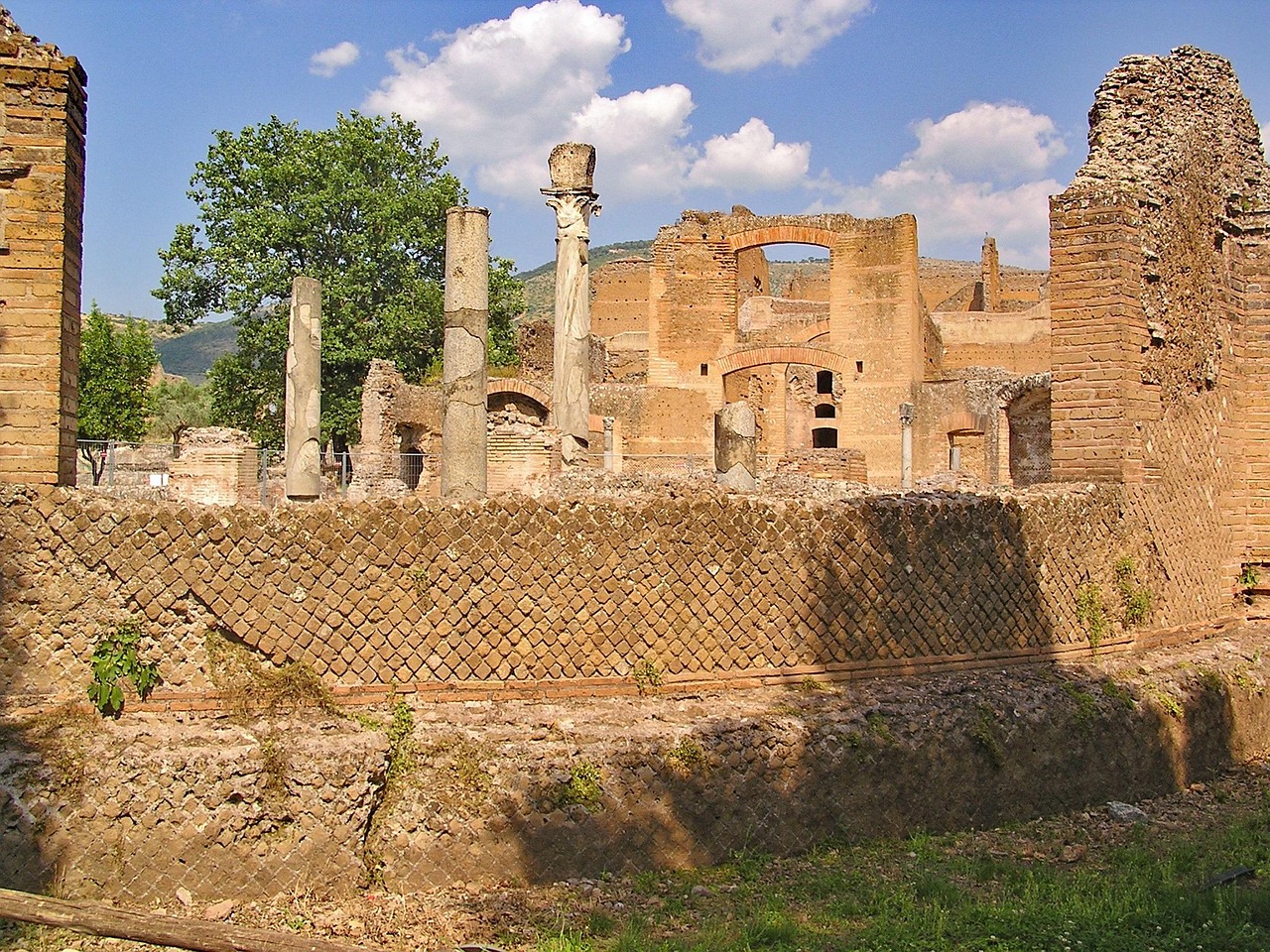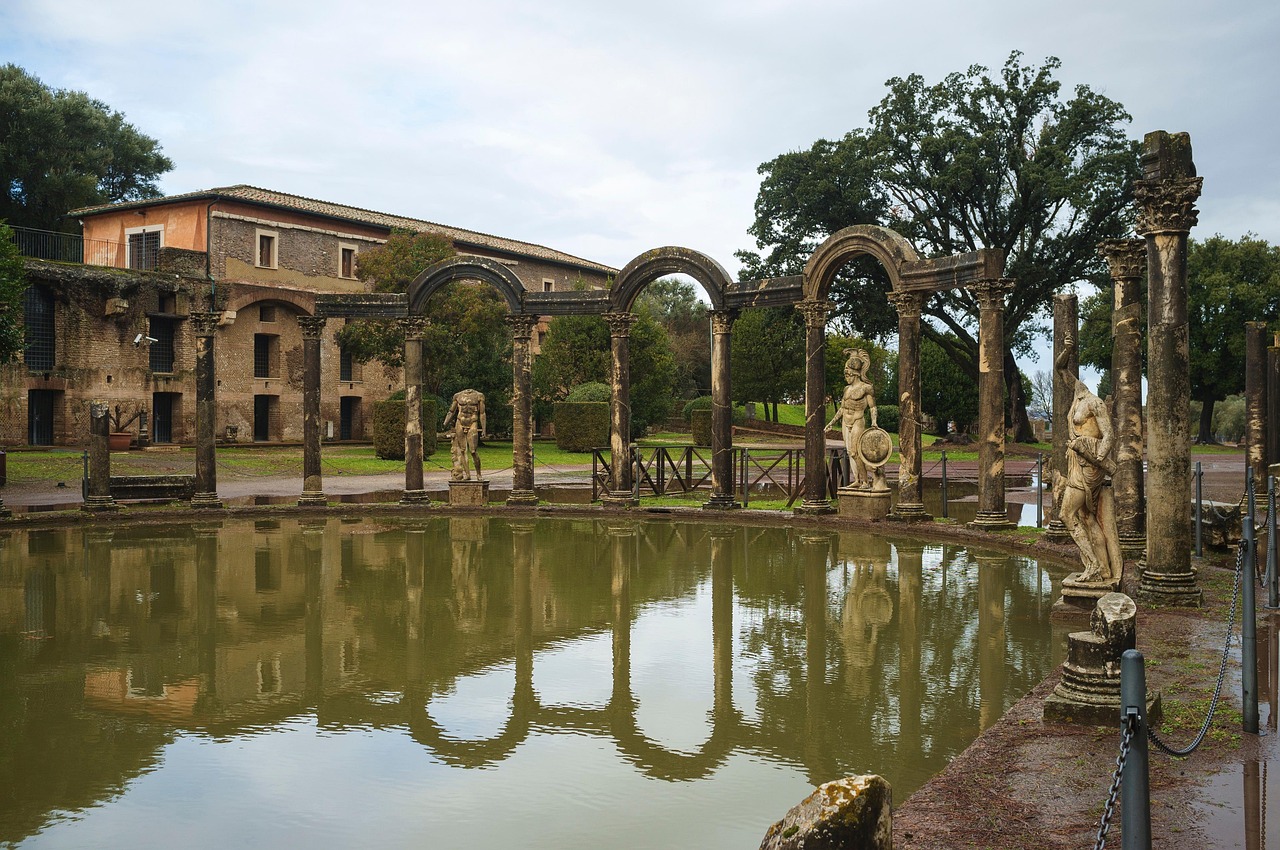Just an hour from Rome lies one of the most impressive remnants of ancient Roman luxury – Hadrian’s Villa. Built around 120 AD, this sprawling 250-acre complex was the ultimate retreat for Emperor Hadrian when he grew tired of city life.
The UNESCO World Heritage Site contains ruins of over 30 major buildings including palaces, baths, libraries, theatres, and gardens that showcase the emperor’s fascination with architecture from across his vast empire.

Walking through the grounds today, I’m always struck by how this wasn’t just a simple country house but a miniature city designed for a ruler who wanted to recreate the wonders he had seen in his travels.
The villa complex features stunning innovations like the Maritime Theatre (a small island retreat within the retreat) and the Canopus (an elegant pool lined with sculptures inspired by Hadrian’s visits to Egypt and Greece).

What makes Hadrian’s Villa truly special is how it offers a glimpse into the mind of one of Rome’s most cultured emperors. Unlike many ancient ruins that require imagination to appreciate, the scale and preservation here allow you to feel what it might have been like to stroll through these grounds nearly 2,000 years ago when fountains flowed, marble gleamed, and the emperor himself might have been entertaining guests amid unimaginable luxury.
The Legacy of Emperor Hadrian
Emperor Hadrian left an indelible mark on the Roman Empire through his leadership and architectural vision. His villa near Tivoli stands as a testament to his creative genius and passion for diverse cultural influences.
Rise to Power
Publius Aelius Hadrianus became emperor in 117 AD following the death of his cousin and adoptive father, Trajan. His path to power is fascinating – born into a Roman family in Spain, he climbed through military and political ranks with strategic connections.
Unlike many emperors before him, Hadrian focused on stabilizing rather than expanding the empire. He traveled extensively throughout Roman territories, spending more than half his reign visiting provinces.
His leadership style emphasized peace and cultural development. Hadrian strengthened borders, including building his famous wall in Britain, while promoting Greek philosophy and arts throughout the empire.
Hadrian’s Architectural Vision
Hadrian’s passion for architecture transformed the Roman landscape. I’ve studied how he personally designed buildings and sometimes even supervised their construction. He wasn’t just an emperor – he was a true architect with technical knowledge.
His architectural style blended traditional Roman elements with Greek and Egyptian influences. This unique vision appears throughout his magnificent villa, where he recreated favorite places from his travels.

The Pantheon in Rome remains his most enduring architectural achievement. Its perfect dome and oculus demonstrate his revolutionary engineering skills that still inspire architects today.
Hadrian’s buildings weren’t just beautiful – they were functional. He pioneered the use of concrete in new ways, allowing for larger and more complex structures than ever before.
Exploring the Grandeur of Hadrian’s Villa
Walking through Hadrian’s Villa feels like stepping into the emperor’s private world of luxury and innovation. This sprawling estate near Tivoli showcases the finest Roman architecture and engineering of its time.
The Marvel of the Maritime Theatre
The Maritime Theatre is my favorite spot in Villa Adriana. This circular structure sits on a small island surrounded by a moat, creating a private retreat within the already massive complex. I was amazed to learn that Hadrian himself designed this space as his personal sanctuary.

The island is reached by two wooden drawbridges that could be raised when the emperor wanted complete privacy. Inside, you’ll find the remains of a miniature villa complete with:
- Small rooms arranged around a central courtyard
- Private baths
- A library
- Study areas

The Maritime Theatre shows Hadrian’s genius for architecture. Its perfect circular design and the way sunlight plays across the water creates a peaceful atmosphere even with today’s crowds of visitors.
The Canopus and Serapeum: A Recreation of the Nile
The Canopus area recreates one of Hadrian’s favorite places in Egypt. It features a long, rectangular pool lined with columns and statues that leads to the impressive domed Serapeum structure.
During my visit, I stood at one end of the 119-meter pool and took in the marble caryatids (female figure columns) that once supported a roof above the water. These are actually replicas—the originals are in museums now.
The Serapeum at the end served as a dining area where guests would recline on couches while enjoying elaborate meals. Hadrian cleverly designed the dome with openings that let in natural light while fountains provided cooling mist on hot summer days.
Water features were central to this space. Small waterfalls and fountains would have created a pleasant soundtrack as the emperor entertained guests.
A Journey Through the Villa’s Leisure Complex
When visiting Hadrian’s Villa, I found the leisure areas truly showcase how Romans perfected the art of relaxation. These spaces blend beauty and function in ways that still impress visitors today, with elaborate gardens and bathing facilities designed for both physical rejuvenation and social interaction.
The Pecile: Garden of Perfection
The Pecile stands as one of the villa’s most impressive leisure spots. Walking along its rectangular portico, I was amazed by the massive garden enclosure spanning about 232 by 97 meters. Emperor Hadrian designed this space to mimic Athens’ famous Stoa Poikile, creating a perfect place for philosophical discussions while strolling.

The garden features a central pool surrounded by meticulously planned greenery. What struck me most was how the portico’s double colonnade provided shade regardless of the time of day or season. This architectural ingenuity allowed for year-round enjoyment.
The Pecile wasn’t just beautiful – it served practical purposes too. The enormous water basin in the center didn’t just look pretty; it helped cool the surrounding area during hot Italian summers.
The Baths: Indulging in Roman Luxury
No Roman leisure complex would be complete without elaborate baths, and Hadrian’s Villa features multiple bathing facilities that truly epitomize luxury. The Small Baths (Piccole Terme) and the Large Baths (Grandi Terme) showcase the Romans’ advanced understanding of heating systems and water management.
I was fascinated by the different bathing rooms – from the caldarium (hot room) with its heated floors to the tepidarium (warm room) and frigidarium (cold room). These spaces weren’t just for cleaning but served as social hubs where important discussions took place.

The baths featured intricate mosaics, marble decorations, and fountains that created a multi-sensory experience. The engineering behind these facilities was remarkable – complex systems of pipes and furnaces maintained perfect temperatures throughout.
Water flowed abundantly through these spaces, demonstrating both the Romans’ engineering prowess and their commitment to the art of leisure.
Cultural Significance and Modern Recognition
Hadrian’s Villa stands as one of the most important Roman sites, influencing art and architecture for centuries while gaining international recognition for its historical value.
Hadrian’s Influence on Arts and Culture
Hadrian’s deep appreciation for Greek culture shaped his villa into a showcase of artistic excellence. The emperor filled his estate with sculptures that captured the finest aspects of Greece’s cultural heritage. Many artists and poets throughout history have drawn inspiration from the villa’s innovative design elements.

The most famous artistic connection involves Antinous, Hadrian’s beloved companion. After Antinous drowned in the Nile, Hadrian honored him through numerous sculptures placed throughout the villa. These portraits became one of the most recognized faces in ancient art.
I’ve noticed how the villa’s blend of architectural styles continues to influence modern designers. When walking through the grounds, you can see how Hadrian’s vision transcended typical Roman designs by incorporating elements from Egypt, Greece, and other cultures he encountered during his travels.
UNESCO World Heritage Site: Conservancy Efforts
Hadrian’s Villa gained UNESCO World Heritage status in 1999, recognizing its exceptional universal value. The designation has helped secure resources for preservation work that I’ve seen progress over my multiple visits.

Conservation teams face significant challenges protecting the site from environmental damage and tourism impacts. Annual visitor numbers have increased steadily, requiring careful management to balance accessibility with preservation.
The archaeological work continues to reveal new discoveries. Just last year, I watched archaeologists uncover previously unknown structures using ground-penetrating radar technology.
Local and international organizations collaborate on educational programs that I highly recommend. These initiatives help visitors understand the villa’s importance to ancient history while raising awareness about conservation needs.
Planning Your Visit to Tivoli
Tivoli makes for an incredible day trip from Rome, and with proper planning, you can experience both Hadrian’s Villa and other nearby treasures like Villa d’Este. The town’s proximity to Rome makes it accessible yet feels worlds away from the city bustle.
Best Time to Visit and Practical Tips
I’ve found that spring (April-May) and fall (September-October) offer the most pleasant weather for exploring Tivoli. Summer can be quite hot, especially when walking around the expansive ruins of Hadrian’s Villa.
Entrance tickets to Hadrian’s Villa cost about €10, but I recommend getting the combined ticket that includes Villa d’Este for around €16 – it’s absolutely worth it! Both sites close on Mondays, so plan accordingly.
For the best experience, arrive early (before 10 AM) to beat both the crowds and the heat. I typically spend 2-3 hours at Hadrian’s Villa and another 2 hours at Villa d’Este.
Transportation options:
- Train from Rome (Termini station to Tivoli)
- Bus service (cheaper but less frequent)
- Private tour (more expensive but includes transport and guide)
Accessibility and Facilities at the Site
Hadrian’s Villa covers roughly 120 hectares with uneven terrain and ancient pathways. Comfortable walking shoes are an absolute must!

The site is partially accessible for wheelchairs, though some areas remain challenging to navigate.
On-site facilities include:
- Clean restrooms near the entrance
- A small café for refreshments
- Gift shop with books and souvenirs
- Limited shaded areas (bring a hat and water!)
I usually pack a small picnic to enjoy in the lovely grounds. For a more substantial meal, head into Tivoli town after your visit.
If you’re interested in Villa Gregoriana, note that it requires separate tickets and additional time. When planning a Tivoli day trip, I recommend focusing on Hadrian’s Villa and Villa d’Este unless you have a full two days to explore.

